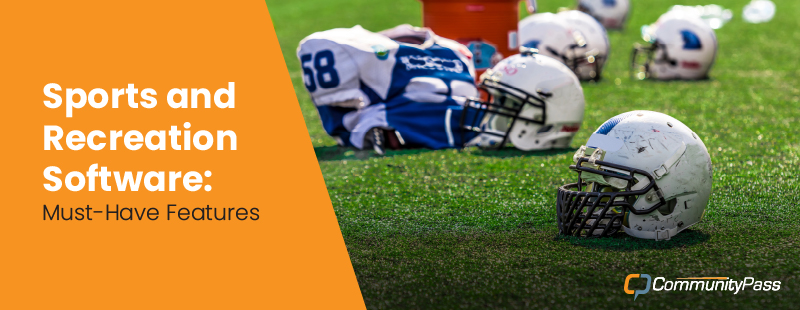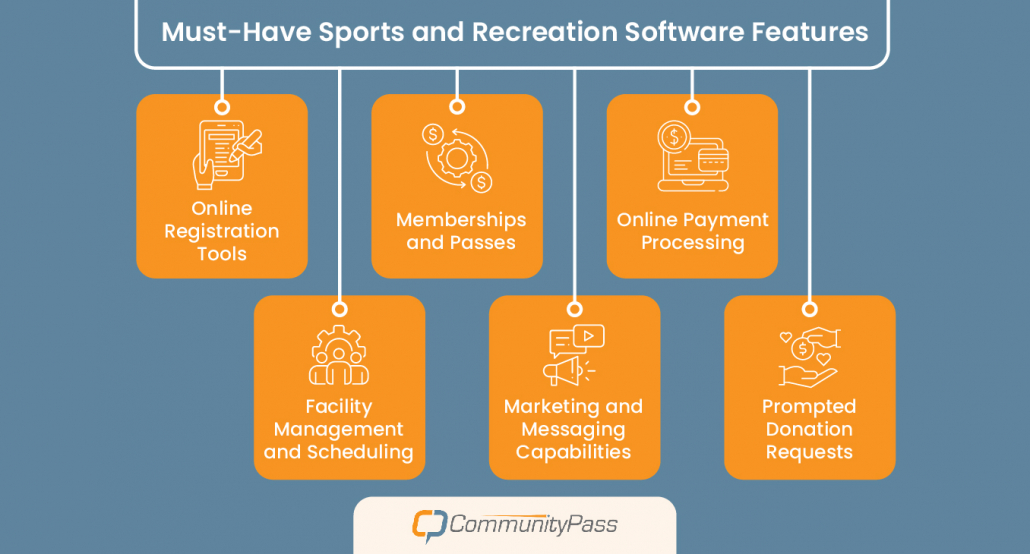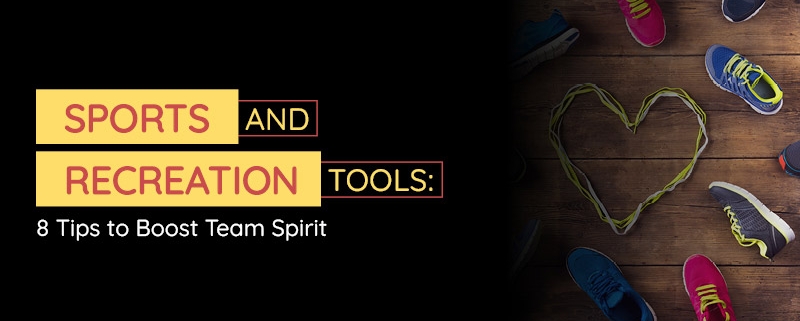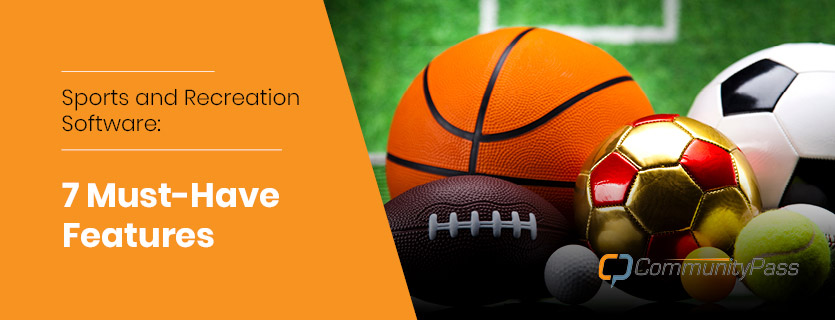Sports and Recreation Software: 6 Must-Have Features
by Kate WhitePeople of all ages benefit from community recreation programs. From children excitedly heading to little league practice to the adults blowing off steam at an after-work basketball game, recreational activities are fun for everyone. However, as you add more of these programs to your roster, management will become more complex—you may need a sports and recreation tool to sort out the details.
That’s where sports and recreation software comes in. With a dedicated solution, you can support a whole host of community activities with less hassle. When purchasing software for your organization, look out for the following features:
- Online registration tools.
- Memberships and passes.
- Secure online payment processing.
- Facility management and scheduling.
- Marketing and messaging capabilities.
- Prompted donation requests.
With these six features in mind, your sports and recreation community will be well on its way to running seamlessly. Let’s jump into the first feature: online registration tools.
1. Online registration tools.
Every program starts with registration. Ideally, this process should be as quick as possible to keep community members engaged at the get-go. However, as your activities become more popular and a greater number of members register, it will be increasingly difficult to keep paper forms organized and processed promptly.
An online registration tool will allow community members to register for a class or activity, purchase event tickets, or register to volunteer through an uncomplicated online process.
Customizable registration tools like the online forms in CommunityPass’ recreation software ensure you have all the necessary information. This includes:
- Name
- Birthdate
- Contact information
- Emergency contact information
- Medical information and allergy alerts
- Waivers
- Permission slips
- Program selection
Additionally, your software should automatically verify an individual’s eligibility for activities during registration. This minimizes cancellations on your side and allows staff members to keep an eye on the bigger picture while the software takes care of the administrative items on your checklist.
2. Memberships and passes.
People come to your sports and recreation center for various reasons, so you should offer a wide range of memberships and passes to accommodate their needs. Your sports and recreation software should enable you to offer all the membership plans and passes you need, including:
- Rolling or recurring memberships
- Seasonal, day, guest, and free passes
- Fixed duration passes
- Family and multi-sibling discounts
- Exclusive membership discounts and packages
With clear, easy-to-use memberships, you’ll encourage greater community involvement and increase participation in your sports and recreation center’s activities. A robust software solution will allow you to offer automatic membership renewal and automatic membership expiration reminders for added convenience.
3. Secure online payment processing.
Online payment processing is a must in today’s technology-centric society. Regardless of whether you run a school, nonprofit, or rec center, make your payment process convenient for visitors and staff members by moving it online.
Your software should come equipped with online payment processing that can:
- Handle single- and multi-tender transactions.
- Keep credit card information on file for ease of use.
- Offer the option to automatically bill membership charges.
- Provide the option to pay online by credit card, debit card, or e-Check.
As community members check out or donate to community fundraising events, they should feel confident that their information is secure. The software you use must be PCI compliant, ensuring the transaction data meets the security standard.
A safe and straightforward payment system will cut down drastically on missed or overdue payments and enable people to sign up and pay for your membership programs conveniently.
4. Facility management and scheduling.
The right parks and recreation software solution not only provides community members access to programs and activities but also makes recreational facility management much easier.
Instead of manually scheduling your programs in countless facilities, the software will allow you to access all the data you and your visitors need in one place. View bookings for buildings, rooms, and fields, and show them on a single, centralized calendar to avoid booking conflicts. Add any closures to the calendar that will affect bookings or your community’s program schedule.
With this information, you can facilitate online rental requests, effortlessly planning around your existing bookings. Plus, you can add photos of your facilities to your website and calendar so guests can see the space they’re reserving.
5. Marketing and messaging capabilities.
You need to be able to communicate with the people in your community, whether it’s about upcoming programs, building closures, or cancellations. While direct mail is a great communication method, digital marketing is a better fit for time-sensitive communication.
A robust sports and recreation software solution will allow you to market through the following channels:
- Your website. According to Getting Attention, your website is one of the primary resources for community members who want to engage with your programs. Your tool should empower you to create and manage such a website, and even help you optimize it for search engines to increase your visibility and grow your audience.
- Email newsletters. Segmentation is the separation of a large group into smaller subgroups based on shared traits and characteristics. Your software should allow you to segment community members into different groups based on their demographics and interests. That way, for example, families with young children will receive information about the new play park opening, and sports-oriented members will receive messages about the tennis court closing temporarily.
- Social media. Platforms such as Facebook, Instagram, LinkedIn, and TikTok allow you to grow your organization’s audience substantially. Choose a sports and recreation solution that integrates with these platforms. Then, manage your social media strategy alongside your other marketing channels.
Don’t underestimate the importance of quick marketing and messaging for the success of your community’s recreation programs. Additionally, your software should help you compile data on the effectiveness of your communications by tracking key metrics such as open rate, click-through rate, and number of followers.
6. Prompted donation requests.
There are many ways for your organization to attain the revenue needed to provide great experiences for your community members. For organizations that accept donations, sports and recreation software can help with that too!
The best tools will incorporate online donation into the registration process so every registrant will be presented with the opportunity to give at the point of purchase, making it much more convenient for them to contribute.
However, that’s not the only way software helps you meet your fundraising goals. It should also support stand-alone fundraising programs, such as a crowdfunding program, fundraising event, or virtual fundraising campaign, that people can access to donate regularly.
Sports and recreation software is made with a simple goal: to make organizing, managing, and participating in community programs easier, faster, and better. As you search for the perfect solution, keep your organization’s unique needs in mind. Find a tool that effectively fulfills these needs and you’ll be on your way to managing an efficient community recreation program!
Author Bio

Sports and Recreation Tools: 8 Tips to Boost Team Spirit
by Kate WhiteWhat’s the best way to teach teamwork and cooperation? How can you blow off steam, make new friends, and stay active? By playing sports, of course! Engaging in sports teams and other recreational activities is a great way to keep healthy and happy. Yet, there are many variables to manage when it comes to coordinating a group of young athletes.
From fundraising endeavors to team management and event planning, there is a lot to balance to provide an effective and organized experience for the team members involved. Whether you’re in charge of a kids’ soccer team or a seniors’ bowling league, here are a few key tips to bring your team’s spirit to the next level.
With the right sports and recreation software solutions, you can:
- Boost team fundraising.
- Streamline registration.
- Simplify management processes.
- Optimize for mobile.
- Design team uniforms.
- Seek out sponsorships.
- Plan out schedules.
- Strengthen communication.
Ready to get started? Let’s jump in.
1. Boost team fundraising.
From jerseys and equipment costs to tournament and travel expenses, you’ll need a bit of funding to get started with your new sports team or league. You know you don’t want to spend all your time soliciting donations, but you may need to host a fundraiser or two to reach your funding goals. Here are a few tips for creating an effective fundraising strategy:
- Utilize fundraising software. One of the essential tools you’ll need to increase your fundraising revenue is an online donation page or dedicated crowdfunding page. This way, you’ll have a solid infrastructure in place to promote your fundraisers to the community and collect donations in mere minutes.
- Host a unique fundraising campaign. Running the same fundraisers year after year can get quite boring and end up leading to donor burnout. How can you boost donations and get the local community involved with your team? Switch things up with some fresh new campaigns, like these unique fundraising ideas from Funds2Orgs.
- Personalize your fundraiser. Try to relate your fundraisers to your specific sport for a more personalized approach. For example, a running club could collect gently worn, used and new running shoes in a shoe drive fundraiser, while a basketball team could host a shoot-a-thon pledge fundraiser. Check out these other sports-related fundraisers for new ideas!
- Make it a team bonding experience. Fundraising is often treated as a chore, but it doesn’t have to be that way. When you position your fundraisers as an exciting way to get to know fellow players, you can strengthen teammate relationships while also earning money! If you throw in a challenge, you can bring out the competitive side of players and turn your fundraising into a game in and of itself.
Fundraising can actually be a fun experience with the right tools in your pocket. Check out these fundraising success stories for a bit of inspiration!
2. Streamline registration.
When you improve the registration process and make it quick and easy for participants to sign up for your teams, you increase the likelihood of sign-ups and boost the participation rate. This way, you’ll have more and fuller teams! On the other hand, if registration is too complicated or inflexible, you run the risk of losing out on potentially interested players.
Don’t make players take time from their already-busy schedules to come in and sign some forms. You’ll boost involvement if you offer online registration right on your website. When you allow your registration to be easily accessible for all, you may exponentially increase the number of participants who get involved—after all, the more, the merrier!
3. Simplify management processes.
Picture this: it’s the first day of basketball practice for your new team. By the time your players have arrived, signed liability waivers, and completed all of the other pregame tasks, you look at your watch and—oh no—practice is over.
You don’t want to spend your valuable (and limited!) playing time dealing with mundane management processes, and neither do your players. According to CommunityPass, with the right recreation management software, you can get a lot of those logistic details out of the way ahead of time.
Encourage participants to complete these processes beforehand:
- Signing waivers: With the implementation of digital liability waivers, you can have all the legal paperwork completed beforehand and prepare for a safe and secure season.
- Processing payments: Online payment processors are great, because they increase the type of payments you’re able to accept—including cash, check, credit, debit, Apple Pay, and more.
- Ordering uniforms: Right along with the initial registration process, be sure to ask players for their t-shirt or jersey size, so you’ll be able to order the right sizes and number of uniforms. Take all the potential complications out of that process as well!
By allowing for (and encouraging!) these processes to be completed online before even arriving to practice, you can maximize the time spent actually practicing for your first big game.
4. Optimize for mobile.
Not only should you ensure that these necessary, albeit mundane, processes can be completed online, but make sure to keep things mobile-friendly as well. This way, you’ll be able to meet busy players and parents right where they are—on their phones.
Individuals should be able to register, pay, and sign forms right from their cell phones at their own convenience, whether that is during their daily commute, waiting in a pickup line, or out at dinner. You don’t want them to say they’ll sign later when they have access to a computer, or they might forget. Life today is always on-the-go, so you’ll have to keep up!
5. Design team uniforms.
A uniform is a great way to garner team spirit and boost morale. When the whole team is dressed in a similar uniform, the visual similarities lead to a strengthened connection between players. A team t-shirt or jersey is typical, but some teams choose to match their bottoms and/or shoes as well.
Uniforms offer the following benefits to your team:
- Solidarity
- Recognition
- Unity
- Simplicity
You can choose a team color, and allow each player to choose their number as well! Consider ordering custom-designed uniforms with each player’s name inscribed for extra personalization.
6. Seek out sponsorships.
In addition to generous donations from families and individual community members, it’s a good idea to seek out partnerships with local businesses. Sponsorships are great opportunities both for your sports team in the form of funding and the business partner in the form of advertising and boosted PR.
Consider reaching out to:
- Professional sports teams
- Local businesses
- Chain restaurants
- Retailers
- Agencies and firms
When you do so, be sure to emphasize the benefits you can offer them. For example, you could have the business logo printed on your custom uniforms or a banner hanging in the stadium or sports facility. As you reach out to potential partners in your community, consider using these sponsorship letter templates to ease your correspondence.
7. Plan out schedules.
Managing schedules is another key element of running a successful sports team. While it tends to be simplest to keep schedules consistent, sometimes that is just not possible. Try to hold practices on the same evening each week to allow team members to plan ahead of time.
You have to balance the availability of many key factors, including:
- The facility
- Team members
- Opponents
- Coaches
- Staff
- Referees
Once you have established a working schedule, find an efficient way to share it with your team (with reminders, too!), so your players don’t miss out on essential games and practices.
8. Strengthen communication.
Communication is crucial among coaches, team members, and league management. As a result, finding a tool with automated messaging capabilities is a must-have for sports and recreation software.
Try to keep an open line of communication between management and players through digital tools. This way, you’ll be able to transmit necessary information easily, and no one will miss out on critical details! For example, you’ll be able to update your team if a game gets rained out, practice is rescheduled, or you need to add an extra meeting.
Additionally, you’ll want to allow for two-way communication so that players can send messages to you as well. It can come in handy when a team member needs to give you a heads up that they will be late to practice or missing a game. You don’t want to be caught off guard by not knowing where your players are!
When you implement these 8 top tips into the management and administration of your sports team, you’ll soon notice critical differences (and improvements!) in the way your team is run. You can adjust each strategy to fit your respective team and its players to create a personalized approach—and boost team spirit for all!
Author Bio
This guest post was contributed by Funds2Orgs.
Wayne Elsey is the founder and CEO of Elsey Enterprises (EE) and a member of the Forbes Business Development Council. Among his various independent brands, he is also the founder and CEO of Funds2Orgs, which is a social enterprise that helps schools, churches, nonprofits, individuals and other organizations raise funds while helping to support micro-enterprise (small business) opportunities in developing nations.
Sports and Recreation Software: 7 Must-Have Features
by Kate WhitePeople of all ages benefit from community recreation programs. From the children excitedly heading to their little league practice to the adults blowing off steam at an after-work basketball game, recreational activities are fun for everyone.
But, with all of the activities that your community supports, you will need sports and recreation software to sort out all the details. After all, why worry about things you don’t need to?
With the right software, you can support a whole host of community activities without the hassle of manual registration, payment, team formation, or facility scheduling. The best software will have:
- Online registration tools.
- Memberships and passes.
- Secure online payment processing.
- Facility management and scheduling.
- Effective league management.
- Targeted marketing and messaging capabilities.
- Prompted donation requests.
Of course, there are a lot of considerations to be made as you make your software selection but if you keep these 7 key features in mind, your sports and recreation community should be well on its way to running perfectly.
Let’s dive into the first must-have feature: online registration tools!
1. Online registration tools.
The beginning of any great team is reliant on the simple act of registration. Every team needs members, but it can be difficult to juggle the paper forms for every single activity you host.
An online registration tool will allow community members to register for a class or activity, purchase tickets to events, or register to volunteer with an uncomplicated, online process.
The software should automatically verify an individual’s eligibility for activities during the registration process so you don’t have to!
Customizable registration tools like the online forms in CommunityPass’ recreation software ensure you have all the information you need. This could include:
- Medical information and allergy alerts
- Waivers
- Permission slips
This will let your staff keep its eye on the bigger picture while the software takes care of the tedious, administrative items on your checklist.
2. Memberships and passes.
People come to your center for a variety of reasons, so you should have a wide range of memberships and passes to accommodate their needs. Some people may only need a guest pass to accompany a friend to a single activity, while others may want to pack their schedule full with a variety of new, exciting programs and need a rolling membership.
Your software should incorporate a variety of passes and membership plans like:
- Rolling or recurring memberships
- Seasonal, day, guest, and free passes
- Fixed duration passes
- Family and multi-sibling discounts
- Exclusive membership discounts and packages
These plans should allow for either auto or manual renewal, as well as expiration date reminders.
A clear, easy-to-use membership plan will encourage greater community involvement and increase participation in your center’s activities.
To see a comprehensive application of membership management to a community pool, click here.
3. Secure online payment processing.
In the world of digital payment scams, some people are skeptical of putting their payment information into a new system.
But people are too busy today to have the time to come down to the rec center or rec administrative office every time they want to make a transaction. It is possible that a community member would decide not to book an activity or program if they deemed the payment process too complicated or unsafe.
Your recreation management software should assure its users that its payment methods are absolutely secure while also providing a wide range of services.
Your software should come equipped with online payment processing that can:
- Handle single- and multi- tender transactions.
- Keep credit card information on file for ease of use.
- Offer the option to automatically bill membership charges.
- Provide the option to pay online by credit card, debit card or e-Check.
As community members check out or donate to community fundraising events, they should feel confident that their information is secure. The software you use must be PCI compliant, ensuring the transaction data meets the security standard.
A safe and straightforward payment system will cut down drastically on missed or overdue payments and enable more people an easier way to sign up and pay for your membership programs.
4. Facility management and scheduling.
Sports and recreation software does not only provide community members easier access to programs and activities, but it makes management of recreational facilities so much easier.
People use your sports and recreation centers and fields for so many programs throughout the entire year. As school gets out for the summer, you are probably flooded with programs to entertain the kids all day. After all, as more children register for summer camps, the more challenging it can be to accommodate all of your program needs.
Don’t get lost in the paperwork!
Instead of manually scheduling your programs in countless facilities, the software will allow you to have all of the data you need in one place. With a simple swipe of your finger, you should be able to switch between buildings, rooms, and fields to see availability and potential reasons for closures that will affect your community’s program schedule.
This information will allow you to facilitate online rental requests with ease but don’t forget to make sure your software has customizable permits for different types of rentals.
5. Effective league management.
Sports teams take a lot of planning and fundraising to execute without a hitch. Coaches put so much work into making sure their team lineup is just perfect and that they have practiced every potential scenario. So, why not make sure they have an efficient way to stay connected and manage their team?
League management software will allow your coaches to build and manage teams while also maintaining communication through a built-in, easy-to-use messaging system.
Once someone registers for a specific activity, the coaches will be able to get to work for the season with a centralized database with the team’s information.
6. Targeted marketing and messaging capabilities
When was the last time you opened up your email to see a mass email chain about something that has nothing to do with you? Arbitrary mass messaging happens all the time, but it doesn’t need to.
Of course, you need to be able to communicate with the people in your community about upcoming programs or building closures, or cancellations, but there has to be a more effective way than a mass email blast.
The best software will allow you to create and send targeted messages, and completely erase the need for sending a message to every person participating in your database.
Your software’s messaging should feature:
- Eligibility and interest verification: The software will filter out users who are not eligible for programs you are marketing based on whatever criteria you set (e.g. program, age, grade, gender).
- Open tracking: You can compile data regarding who opens your messages so you can more effectively target a specific audience.
Don’t underestimate the importance of quick, efficient, and effective communication for the success of your community’s recreation programs.
7. Prompted Donation Requests.
It’s impossible to get around the question of money when you think about how to run a community rec center. To host any number of programs, you need capital to make things happen.
There are so many ways you raise money for your community centers and as always, your software should handle this so you can worry less and plan more fun activities for your community.
The best software will incorporate online donation tools into the registration process so every member will be presented with the opportunity to give while they already have their wallets out.
While everyone has the opportunity to donate when registering for a program, this is not the only way your software can help you meet your fundraising goals. It should support stand-alone fundraising programs that people can access to regularly donate and encourage fundraising ideas that suit your community’s needs.
If you want even more ideas for raising money for your organization, check out Bonfire’s sports team fundraising ideas.
Sports and recreation software is made with this simple goal in mind: to make organizing, managing, and participating in community programs easier, faster, and better.
Now you know everything you need to know to choose which recreation management software is best for your community, so why wait? Get on your way to managing an efficient community recreation program!
Author Bio

Crowdfunding Resources
Fundraising Resources:
Popular Resources

Fundly is dedicated to providing you with the tools you need to raise money for whatever your cause may be.






















